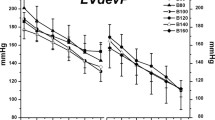Abstract
Objective: Lidocaine exhibits a cardioplegic action via acute inhibition of sodium influx into the myocardial cells. In terms of the cardiac function and calcium dynamics in the myocardial cells, we investigated the myocardial protective effect of addition of FC43 of Perfluorochemicals, which has an excellent oxygen transport function to meet the myocardial oxygen demand, on lidocaine-induced cardioplegia.Methods: Isolated rat hearts were perfused with Langendorff mode and were divided to three experimental groups. During of preservation, these hearts were perfused continuously with the next three solution, potassium chloride was added to Krebs-Henseleit bicarbonate buffer to make potassium concentration of 20 mM in the first group (Group A), 2 mM lidocaine was added to Krebs-Henseleit bicarbonate buffer in the second group (Group B), and 2 mM lidocaine and 20% FC43 were added to Krebs-Henseleit bicarbonate buffer in the third group (Group C). After 60 minutes of continuous perfusion, the cardiac function and the intracellular calcium concentration in Groups A and B during cardioplegia were measured. Futhermore, after 360 minutes of continuous coronary perfusion, the cardiac function were measured in Group B and Group C. Results andConclusions: Lidocaine cardioplegia showed a good recovery of cardiac function, because lidocaine induced prompt cardiac arrest by blocking sodium influx and inhibited the intracelluar calcium overload by the following inhibiton of sodium — calcium channels. Moreover, our results suggested that combining Perfluorochemicals with lidocaine produced a more effective myocardial-preservation that meets the myocardial oxygen demand during long-term cardiac arrest.
Similar content being viewed by others
References
Inoue K. The evaluation of the myocardial protective effect of various cardioplegic solutions: The experimental studies by isolated working rat hearts. J Showa Med Assoc 1979; 39: 143–57.
Hearse DJ, Garlick PB, Humphrey SM. Ischemic contracture of the myocardium. Mechanism and prevention. Am J Cardiol 1977; 39: 986–93.
Tani M, Neely JR. Role of intracellular Na+ in Ca²+ overload and depressed recovery of ventricular function of reperfused ischemic rat hearts. Possible involvement of H+-Na+ and Na+-Ca2+ exchange. Circ Res 1989; 65: 1045–56.
Dennis E, Nicholas S. Bupivacaine and lidocaine blockade of calcium-mediated slow action potential in guinea pig ventricular muscle. J Pharmacol Exp Thher 1987; 242: 1001–5.
Sutko JL, Bers DM, Reeves JP. Postrest inotrophy in rabbit ventricle. Na+-Ca2+ exchange determined sarcoplasmic reticulum Ca content. Am J Physiol 1986; 256: 654–61.
Bers DM, Christensen DN. Functional interconnection of rest decay and reat ventricle depends on Na/Ca exchange. J Mol Cell Cardiol 1990; 22: 715–23.
Bretschneider HJ, Hubner G, Knoll D, Lohr B, Nordbeck H, Spieckermann PG. Myocardial resistance and tolerance to ischemia: physiological and biochemical basis. J Cardiovasc Surg 1975; 16: 241–60.
Buckberg G, Dyson C, Emerson R. Techniques for administering clinical cardioplegia-Blood cardioplegia In: Engelman R, Levitsky S, ed. A textbook of clinical cardioplegia. New York: 1982: 305–16.
Kosugi K. O2 Transport, CO2 Transport. Circulation control 1982; 3: 21–6.
Maeda S, Hirose H, Matsuda H, Shirokura R, Kaneka N, Sasako K, et al. Roles of potassium and oxygen on hypothermic cardioplegic myocardial protection. Jpn Ann Thorac Surg 1984; 4: 413–7.
Inoue K, Honda O, Hanabusa Y, Hanabusa Y, Ando S, Ozawa A, et al. The myocardial protection of immersion hearts in perfluorochemicals during ischemia. Jpn J Cardiovasc Surg 1995; 24: 305–10.
Vollmer B. Hypothermic continuous blood cardioplegia. In: Tomas AS, ed. Warm heart surgery. London: Edward Arnold, 1995: 26–30.
Barner H, Jellinek M. Blood cardioplegia-An introduction. In: Engelman R, Levitsky S, ed. A textbook of clinical cardioplegia. New York: 1982: 227–39.
Sakai A, Sohara Y, Maeta H, Hori H, Onizuka M, Ooshima N. Evaluation of blood cardioplegia in view of coronary microcirculation: preliminary report of experimental studies. Jpn Ann Thorac Surg 1984; 4: 422–5.
Nakai K, Usuba A, Motoki R, Takahashi T. Effect of a hemoglobin-encapsulated liposomes, neo red cell, in perfused rat coronary circulation. Jpn J Artif Organs 1997; 26: 553–6.
Wada S, Kajihara H, Murakami H, Mukai S, Kurisu Y, Sueda T, et al. The effectiveness of perfluorotrbutylamine/pluronic F-68 stem-emulsion (FC43se) against xenograft rejection in the guinea pig — to — rat model. Jpn Assoc Thorac Sueg 1995; 43: 1587–94.
Endo M, Hasegawa T, Shiono M, Orime Y, Hata H, Yagi S, et al. Experimental study on myocardial preservation by perfluorochemical. Jpn Ann Thorac Surg 1990; 10: 51–5.
Author information
Authors and Affiliations
Rights and permissions
About this article
Cite this article
Bito, A., Inoue, K., Asano, M. et al. Experimental myocardial preservation study of adding perfluorochemicals (FC43) in lidocaine cardioplegia. Jpn J Thorac Caridovasc Surg 48, 280–290 (2000). https://doi.org/10.1007/BF03218140
Received:
Accepted:
Issue Date:
DOI: https://doi.org/10.1007/BF03218140




